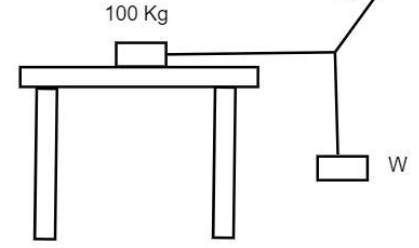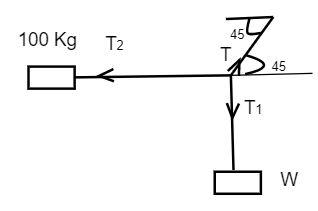
The system shown in the figure is in equilibrium. The maximum value of $W$ . So that the maximum value of $W$ . So that the maximum value of static frictional force on $100\,Kg$ body is $450\,N$ , will be:-

A) $100\,N$
B) $250\,N$
C) $450\,N$
D) $1000\,N$
Answer
218.1k+ views
Hint: The system is said to be equilibrium if all the force acts on the body is the same on all sides or else no force acts on the body. Draw the free body diagram of the given system of force. Equate the force acts on the body as from the free body diagram to find the weight of the body suspended.
Complete step by step solution:
It is given that the
Mass of the body, $m = 100\,Kg$
Maximum value of the static frictional force, $f = 450\,N$
Since the system is in equilibrium, all the force that acts on the system will be equal to each other. Let us draw the free body diagram from the given diagram.

${T_1} = {T_2} = T$
Splitting the force along the inclination into the horizontal component and the vertical component. That is $T\sin {45^ \circ }$ and $T\cos {45^ \circ }$ .
Substituting the known values in the above equation, we get
${T_1} = W = T\sin {45^ \circ }$ …………………………(1)
${T_2} = f = T\cos {45^ \circ }$ ………………………..(2)
We know that the value of the $\sin {45^ \circ }$ and the $\cos {45^ \circ }$ is $\dfrac{1}{{\sqrt 2 }}$ . Since the right hand side of both the equation (1) and (2) are equal, the left hand side must also be the same.
$\Rightarrow W = f$
Substituting the value of the maximum static frictional force in the above step, we get
$\Rightarrow W = 450\,N$
Thus the option (C) is correct.
Note: Frictional force is the force offered by the surface against the movement of the body. In the above solution, the diagram shows that the $100\,Kg$ block is kept on a table. It stands on a certain place mainly due to the static friction it has. That so this force equates to its static friction.
Complete step by step solution:
It is given that the
Mass of the body, $m = 100\,Kg$
Maximum value of the static frictional force, $f = 450\,N$
Since the system is in equilibrium, all the force that acts on the system will be equal to each other. Let us draw the free body diagram from the given diagram.

${T_1} = {T_2} = T$
Splitting the force along the inclination into the horizontal component and the vertical component. That is $T\sin {45^ \circ }$ and $T\cos {45^ \circ }$ .
Substituting the known values in the above equation, we get
${T_1} = W = T\sin {45^ \circ }$ …………………………(1)
${T_2} = f = T\cos {45^ \circ }$ ………………………..(2)
We know that the value of the $\sin {45^ \circ }$ and the $\cos {45^ \circ }$ is $\dfrac{1}{{\sqrt 2 }}$ . Since the right hand side of both the equation (1) and (2) are equal, the left hand side must also be the same.
$\Rightarrow W = f$
Substituting the value of the maximum static frictional force in the above step, we get
$\Rightarrow W = 450\,N$
Thus the option (C) is correct.
Note: Frictional force is the force offered by the surface against the movement of the body. In the above solution, the diagram shows that the $100\,Kg$ block is kept on a table. It stands on a certain place mainly due to the static friction it has. That so this force equates to its static friction.
Recently Updated Pages
Chemical Properties of Hydrogen - Important Concepts for JEE Exam Preparation

JEE General Topics in Chemistry Important Concepts and Tips

JEE Atomic Structure and Chemical Bonding important Concepts and Tips

JEE Amino Acids and Peptides Important Concepts and Tips for Exam Preparation

JEE Extractive Metallurgy Important Concepts and Tips for Exam Preparation

Algebra Made Easy: Step-by-Step Guide for Students

Trending doubts
JEE Main 2026: Application Form Open, Exam Dates, Syllabus, Eligibility & Question Papers

Derivation of Equation of Trajectory Explained for Students

Hybridisation in Chemistry – Concept, Types & Applications

Understanding the Angle of Deviation in a Prism

Understanding Collisions: Types and Examples for Students

Understanding Atomic Structure for Beginners

Other Pages
JEE Advanced Marks vs Ranks 2025: Understanding Category-wise Qualifying Marks and Previous Year Cut-offs

Units And Measurements Class 11 Physics Chapter 1 CBSE Notes - 2025-26

NCERT Solutions For Class 11 Physics Chapter 8 Mechanical Properties Of Solids

Motion in a Straight Line Class 11 Physics Chapter 2 CBSE Notes - 2025-26

NCERT Solutions for Class 11 Physics Chapter 7 Gravitation 2025-26

How to Convert a Galvanometer into an Ammeter or Voltmeter




